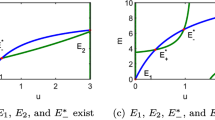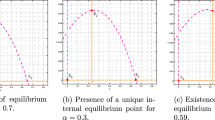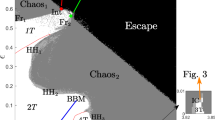Abstract
In this article, a system of delay differential equations to represent the predator–prey dynamics with weak Allee effect in the growth of predator population is discussed. The delay parameter regarding the time lag corresponds to the predator gestation period. Mathematical features such as uniform persistence, permanence, stability, Hopf bifurcation at the interior equilibrium point of the system are analyzed and verified by numerical simulations. Bistability between different equilibrium points is properly discussed. The chaotic behaviors of the system are recognized through bifurcation diagram, Poincare section, and maximum Lyapunov exponent. By constructing a suitable Lyapunov functional for the time-delayed model, global asymptotic stability analysis of the positive equilibrium points has been performed separately. It can be observed that the Allee parameter \(\theta \) can destabilize the non-delay system, whereas \(\theta \) and the attack rate of predator can stabilize the time-delayed model and can control the chaotic oscillations through period-halving bifurcation. The optimal predator control policy with Allee parameter (\(\theta \)) as the control parameter is also discussed.



















Similar content being viewed by others
References
Dickman, C.R.: Overview of the Impacts of Feral Cats on Australian Native Fauna. Australian Nature Conservation Agency, Canberra (1996)
Dickman, C.R.: Impact of exotic generalist predators on the native fauna of Australia. Wildl. Biol. 2, 185–195 (1996)
Rolls, E.C.: They All Ran. Wild The Story of Pests on the Land in Australia. Angus and Robertson, Sydney (1969)
Glen, A.S., Dickman, C.R.: Effects of bait-station design on the uptake of baits by non-target animals during control programmes for foxes and wild dogs. Wildl. Res. 30, 147–149 (2003)
Berec, L., Angulo, E., Courchamp, F.: Multiple Allee effects and population management. Trends Ecol. Evol. 20, 185–191 (2006)
Boukal, D.S., Berec, L.: Modelling mate-finding Allee effects and populations dynamics, with applications in pest control. Popul. Ecol. 51, 445–458 (2009)
Gascoigne, J.C., Lipccius, R.N.: Allee effect driven by predation. J. Appl. Ecol. 41, 801–810 (2004)
Yamanaka, T., Liebhold, A.M.: Spatially implicit approaches to understanding the manipulation of mating success for insect invasion management. Popul. Ecol. 51, 427–444 (2009)
Allee, W.C.: Anim. Aggreg. A study in general sociology. University of Chicago Press, Chicago (1931)
Ferdy, J.B., Austerlitz, F., Moret, J., Gouyon, P.H., Godelle, B.: Pollinator-induced density dependence in deceptive species. Oikos 87, 549–560 (1999)
Courchamp, F., Grenfell, B., Clutton-Brock, T.: Impact of natural enemies on obligately cooperatively breeders. Oikos 91, 311–322 (2000)
Courchamp, F., Berec, L., Gascoigne, J.: Allee Effects in Ecology and Conservation. Oxford University Press, Oxford (2008)
Wang, M.H., Kot, M.: Speeds of invasion in a model with strong or weak Allee effects. Math. Biosci. 171, 83–97 (2001)
Biswas, S., Sasmal, S.K., Saifuddin, Md, Chattopadhyay, J.: On existence of multiple periodic solutions for Lotka–Volterra’s predator–prey model with Allee effects. Nonlinear Stud. 22(2), 189–199 (2015)
Pablo, A.: A general class of predation models with multiplicative Allee effect. Nonlinear Dyn. 78(1), 629–648 (2014)
Peng, F., Kang, Y.: Dynamics of a modified Leslie–Gower model with double Allee effects. Nonlinear Dyn. 80, 1051–1062 (2015)
Sun, G.Q.: Mathematical modeling of population dynamics with Allee effect. Nonlinear Dyn. 85(1), 1–12 (2016)
Rocha, J.L., Fournier-Prunaret, D., Taha, A.K.: Big bang bifurcations and Allee effect in blumbergs dynamics. Nonlinear Dyn. 77(4), 1749–1771 (2014)
Dong, T., Liao, X.: Bogdanov–Takens bifurcation in a trineuron BAM neural network model with multiple delays. Nonlinear Dyn. 71(3), 583–595 (2013)
Sarwardi, S., Haque, M., Mandal, P.K.: Ratio-dependent predator–prey model of interacting population with delay effect. Nonlinear Dyn. 69, 817–836 (2012)
Wang, J., Jiang, W.: Bifurcation and chaos of a delayed predator–prey model with dormancy of predators. Nonlinear Dyn. 69, 1541–1558 (2012)
Xu, C., Tang, X., Liao, M., He, X.: Bifurcation analysis in a delayed Lotka–Volterra predator–prey model with two delays. Nonlinear Dyn. 66, 169–183 (2011)
MacDonald, N.: Biological Delay Systems: Linear Stability Theory. Cambridge University Press, Cambridge (1989)
Kuang, Y.: Delay Differential Equation with Applications in Population Dynamics. Academic Press, New York (1993)
Freedman, H.I., Rao, V.S.H.: The tradeoff between mutual interference and time lag in predator prey models. Bull. Math. Biol. 45, 991–1004 (1983)
Freedman, H.I., So, J., Waltman, P.: Coexistence in a model of competition in the chemostat incorporating discrete time delays. SIAM J. Appl. Math. 49, 859–870 (1989)
Wang, W., Ma, Z.: Harmless delays for uniform persistence. J. Math. Anal. Appl. 158, 256–268 (1991)
Xua, R., Gan, Q., Ma, Z.: Stability and bifurcation analysis on a ratio-dependent predator–prey model with time delay. J. Comput. Appl. Math. 230, 187–203 (2009)
Ghosh, K., Samanta, S., Biswas, S., Rana, S., ELmojtaba, I.M., Kesh, D.K., Chattopadhyay, J.: Stability and bifurcation analysis of an eco-epidemiological model with multiple delays. Nonlinear Stud. 23(2), 167–208 (2016)
Huang, G., Takeuchi, Y.: Global analysis on delay epidemiological dynamic models with nonlinear incidence. J. Math. Biol. 63(1), 125–139 (2011)
Mukandavire, Z., Garira, W., Chiyaka, C.: Asymptotic properties of an HIV/AIDS model with a time delay. J. Math. Anal. Appl. 330(2), 916–933 (2007)
Ma, J., Song, X., Jin, W., Wang, C.: Autapse-induced synchronization in a coupled neuronal network. Chaos Solitons Fractals 80, 31–38 (2015)
Qin, H., Wu, Y., Wang, C., Ma, J.: Emitting waves from defects in network with autapses. Commun. Nonlinear Sci. Numer. Simul. 23(1), 164–174 (2015)
Yao, C., Ma, J., Li, C., He, Z.: The effect of process delay on dynamical behaviors in a self-feedback nonlinear oscillator. Commun. Nonlinear Sci. Numer. Simul. 39, 99–107 (2016)
Biswas, S., Sasmal, S.K., Samanta, S., Saifuddin, Md, Ahmed, Q.J.K., Chattopadhyay, J.: A delayed eco-epidemiological system with infected prey and predator subject to the weak Allee effect. Math. Biosci. 263, 198–208 (2015)
Biswas, S., Samanta, S., Chattopadhyay, J.: Cannibalistic predator–prey model with disease in predator—a delay model. Int. J. Bifurc. Chaos 25(10), 1550130 (2015)
Liao, M.X., Tang, X.H., Xu, C.J.: Bifurcation analysis for a three-species predator–prey system with two delays. Commun. Nonlinear Sci. Numer. Simul. 17, 183–194 (2012)
Meng, X.Y., Huo, H.F., Zhang, X.B., Xiang, H.: Stability and Hopf bifurcation in a three-species system with feedback delays. Nonlinear Dyn. 64, 349–364 (2011)
Pal, N., Samanta, S., Biswas, S., Alquran, M., Al-Khaled, K., Chattopadhyay, J.: Stability and bifurcation analysis of a three-species food chain model with delay. Int. J. Bifurc. Chaos 25(09), 1550123 (2015)
Li, L.: Bifurcation and chaos in a discrete physiological control system. Appl. Math. Comput. 252, 397–404 (2015)
Sun, G.Q., Zhang, J., Song, L.P., Jin, Z., Li, B.L.: Pattern formation of a spatial predator prey system. Appl. Math. Comput. 218(22), 11151–11162 (2012)
Li, L.: Periodic solutions in reaction diffusion equations with time delay. Chaos Solitons Fractals 78, 33–38 (2015)
Li, L.: Patch invasion in a spatial epidemic model. Appl. Math. Comput. 258, 342–349 (2015)
Li, L., Jin, Z., Li, J.: Periodic solutions in a herbivore-plant system with time delay and spatial diffusion. Appl. Math. Model. 40(7), 4765–4777 (2016)
Sun, G.Q., Wang, S.L., Ren, Q., Jin, Z., Wu, Y.P.: Effects of time delay and space on herbivore dynamics: linking inducible defenses of plants to herbivore outbreak. Sci. Rep. 5, 11246 (2015)
Sun, G.Q., Jusup, M., Jin, Z., Wang, Y., Wang, Z.: Pattern transitions in spatial epidemics: mechanisms and emergent properties. Phys. Life Rev. 19, 43–73 (2016)
Sun, G.Q., Wu, Z.Y., Wang, Z., Jin, Z.: Influence of isolation degree of spatial patterns on persistence of populations. Nonlinear Dyn. 83(1–2), 811–819 (2016)
Sun, G.Q., Wang, C.H., Wu, Z.Y.: Pattern dynamics of a Gierer Meinhardt model with spatial effects. Nonlinear Dyn. 88(2), 1385–1396 (2017)
Biswas, S., Saifuddin, M., Sasmal, S.K., Samanta, S., Pal, N., Ababneh, F., Chattopadhyay, J.: A delayed prey–predator system with prey subject to the strong Allee effect and disease. Nonlinear Dyn. 84, 1569–1594 (2016)
Biswas, S., Sasmal, S.K., Samanta, S., Saifuddin, M., Pal, N., Chattopadhyay, J.: Optimal harvesting and complex dynamics in a delayed eco-epidemiological model with weak Allee effects. Nonlinear Dyn. 87(3), 1553–1573 (2016)
Morozov, A., Petrovskii, S., Li, B.L.: Bifurcations and chaos in a predator–prey system with the Allee effect. Proc. R. Soc. B 271, 1407–1414 (2004)
Saifuddin, M., Biswas, S., Samanta, S., Sarkar, S., Chattopadhyaya, J.: Complex dynamics of an eco-epidemiological model with different competition coefficients and weak Allee in the predator. Chaos Solitons Fractals 91, 270–285 (2016)
Courchamp, F., Chapuis, J.L., Pascal, M.: Mammal invaders on islands: impact, control and control impact. Biol. Rev. 78(3), 347–383 (2003)
Freckleton, R.P.: Biological control as a learning process. Trends Ecol. Evol. 15(7), 263–264 (2000)
Sussman, R.W., Garber, P.A.: A new interpretation of the social organisation and mating system of the Callitrichidae. Int. J. Primatol. 8, 73–92 (1987)
Zhou, S.R., Liu, Y.E., Wang, G.: The stability of predator–prey systems subject to the Allee effects. Theor. Popul. Biol. 67, 23–31 (2005)
Dennis, B.: Allee effects: population growth, critical density, and the chance of extinction. Nat. Resour. Model. 3, 481–538 (1989)
McCarthy, M.A.: The Allee effect, finding mates and theoretical models. Ecol. Model. 103, 99–102 (1997)
Scheuring, I.: Allee effect increases the dynamical stability of populations. J. Theor. Biol. 199, 407–414 (1999)
Wiggins, S.: Introduction to Applied Nonlinear Dynamical Systems and Chaos, vol. 2. Springer, Berlin (2003)
Huang, J., Gong, Y., Ruan, S.: Bifurcation analysis in a predator–prey model with constant-yield predator harvesting. Discrete Contin. Dyn. Syst. Ser. B 18, 2101–2121 (2013)
Huang, J., Ruan, S., Song, J.: Bifurcations in a predator prey system of Leslie type with generalized Holling type III functional response. J. Differ. Equ. 257(6), 1721–1752 (2014)
Hassard, B., Kazarinof, D., Wan, Y.: Theory and Applications of Hopf Bifurcation. Cambridge University Press, Cambridge (1981)
Marino, S., Hogue, I.B., Ray, C.J., Kirschner, D.E.: A methodology for performing global uncertainty and sensitivity analysis in systems biology. J. Theor. Biol. 254, 178–196 (2008)
Sprott, J.C.: Chaos and Time Series Analysis. Oxford University Press, Oxford (2003). (Chapter 5)
Wolf, A., Swift, J., Swinney, H., Vastano, J.: Determining Lyapunov exponents from a time series. Phys. D 16, 285–317 (1985)
Zaman, G., Kang, Y.H., Jung, H.: Optimal treatment of an SIR epidemic model with time delay. BioSyst. 98, 43–50 (2009)
Jana, S., Kar, T.: A mathematical study of a prey–predator model in relevance to pest control. Nonlinear Dyn. 74, 667–674 (2013)
Kumar, D., Chakrabarty, S.P.: A comparative study of bioeconomic ratio-dependent predator–prey model with and without additional food to predator. Nonlinear Dyn. 80(1–2), 23–38 (2015)
Biswas, S., Subramanian, A., ELMojtaba, E.M., Chattopadhyay, J., Sarkar, S.: Optimal combinations of control strategies and cost-effective analysis for visceral leishmaniasis disease transmission. Plos One 12(2), e0172465 (2017)
Allen, J.C., Schaffer, W.M., Rosko, D.: Chaos reduces species extinctions by amplifying local population noise. Nature 364, 229–232 (1993)
Huisman, J., Weissing, F.J.: Biodiversity of plankton by species oscillations and chaos. Nature 402, 407–410 (1999)
Reynolds, J.C., Tapper, S.C.: Control of mammalian predators in game management and conservation. Mamm. Rev. 26(2–3), 127–155 (1996)
Acknowledgements
I would like to thank the handling editor and the reviewers for their careful reading and valuable comments. Special thanks are due to Prof. Joydev Chattopadhyay for his useful discussions.
Author information
Authors and Affiliations
Corresponding author
Appendix
Appendix
First, consider the transformation \(z_{1}(t) = S-S_{*}\), \(z_{2}(t) = P-P_{*}\).
Let \(\tau =\tau ^{*}+\mu \), \(\mu \in \mathbf {R}\). Then \(\mu =0\) is the Hopf bifurcation value of system (3). Equation (3) can be written in the form
where \(z(t)=(z_{1}(t), z_{2}(t))^\mathrm{T}\in \mathbf {R^{2}}\). For \(\psi =(\psi _{1}, \psi _{2})^\mathrm{T}\in \mathbf {C}([-1, 0], \mathbf {R^{2}_{+}})\), \(L_{\mu }: \mathbf {C}\rightarrow \mathbf {R}\) and \(F: \mathbf {R}\times \mathbf {C}\rightarrow \mathbf {R}\) are given by
and
where
By the Riesz representation theorem, there exists a function \(\eta (\theta , \mu )\) of bounded variation for \(\theta \in [-1, 0]\) such that
In fact,
where \(\delta \) is defined by \(\delta (\theta )=\Big \{^{1, \ \ \theta =0,}_{0, \ \ \theta \ne 0.} \)
For \(\psi \in \mathbf {C}^{1}\left( [-1, 0], \mathbf {R^{3}_{+}}\right) \), define
and
Then system (45) is of the form
where \(z_{t}(\theta )=z_{t}(t+\theta )\) for \(\theta \in [-1, 0]\).
For \(\phi \in \mathbf {C}^{1}([0, 1], (\mathbf {R^{3}_{+}})^{*})\), define
and a bilinear inner product
where \(\eta (\theta )=\eta (\theta , 0)\). Clearly, A(0) and \(A^{*}\) are adjoint operators. We know that \(\pm i\rho _{0}\tau ^{*}\) are eigenvalues of A(0). So, they are also eigenvalues of \(A^{*}\). Now we search for the eigenvector of A(0) and \(A^{*}\) corresponding to \(i\rho _{0}\tau ^{*}\) and \(-i\rho _{0}\tau ^{*}\), respectively.
The author assumes that \(q(\theta )=(1, u)^\mathrm{T} e^{i\rho _{0}\tau ^{*}\theta }\) and \(q^{*}(s)\) are the eigenvectors of A(0) and \(A^{*}\) corresponding to \(i\rho _{0}\tau ^{*}\) and \(-i\rho _{0}\tau ^{*}\). Then, \(A(0)q(\theta )=i\rho _{0}\tau ^{*}q(\theta )\). By the definition of A(0) and from (48), it follows that
Then, \(q(0)=(1, u)^\mathrm{T}\),
and
where
D can be chosen in such a way that \(\langle q^{*}(s), q(\theta ) \rangle =1\), \(\langle q^{*}(s), \overline{q}(\theta ) \rangle =0\).
Hence,
Thus, \(\overline{D}=\frac{1}{\left[ 1+\overline{u^{*}}u+ \tau ^{*} \overline{u^{*}}(a_4+a_5 u) e^{-i\rho _{0}\tau ^{*}} \right] }\).
To describe the center manifold \(\mathbf {C}_{0} \) at \(\mu =0 \), we compute the coordinates by using the same notations and procedures as proposed by [63].
Let \( z_{t}\) be the solution of Eq. (45) when \(\mu =0 \).
Define
On the center manifold \(\mathbf {C}_{0} \), we have
where
\(\text {z}\) and \(\overline{\text {z}}\) are local coordinates for center manifold \(\mathbf {C}_{0}\) in the direction of \(q^{*}\) and \(\overline{q}^{*}\). Here W is real when \(z_{t}\) is real. For solution \(z_{t} \in \mathbf {C}_{0}\) of Eq. (45), since \(\mu =0\),
so \(\dot{\text {z}}=i\rho _{0}\tau ^{*}\text {z}+g(\text {z}, \overline{\text {z}})\) with
Then from Eq. (52),
Thus, from Eq. (53),
Comparing the coefficients with (53) one can obtain that
To calculate the value of \(g_{21}\), we need to compute the values of \(W_{20}(\theta )\) and \(W_{11}(\theta )\). From Eqs. (49) and (52),

where
Expanding the above series and comparing the corresponding coefficients,
From Eq. (57), for \(\theta \in [-1, 0),\)
Comparing the coefficients with (58) gives that
and
Since \(q(\theta )=(1, u)^\mathrm{T} e^{i\rho _{0}\tau ^{*}\theta }\),
where \(E_{1}=(E_{1}^{(1)}, E_{1}^{(2)}) \in \mathbf {R}^{2}\) is a constant vector.
Similarly, from Eqs. (59) and (62),
where \(E_{2}=(E_{2}^{(1)}, E_{2}^{(2)}) \in \mathbf {R}^{2}\) is a constant vector.
In what follows, \(E_{1}\) and \(E_{2}\) in (63) and (64), respectively, should be chosen appropriately. From the definition of A and (59),
and
where \(\eta (\theta )=\eta (0, \theta )\). From (59),
and
Noting that
and
and putting (63) and (67) into (65),
which implies that
It follows that
where
Similarly, putting (64) and (68) into (66),
which implies that
and hence,
where
Rights and permissions
About this article
Cite this article
Biswas, S. Optimal predator control policy and weak Allee effect in a delayed prey–predator system. Nonlinear Dyn 90, 2929–2957 (2017). https://doi.org/10.1007/s11071-017-3854-x
Received:
Accepted:
Published:
Issue Date:
DOI: https://doi.org/10.1007/s11071-017-3854-x




